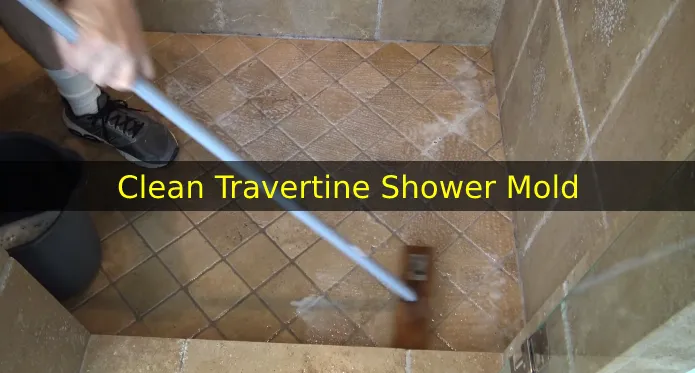Last Updated on July 23, 2023
Uninvited mold has an uncanny knack for appearing in the most inconvenient places. Getting rid of mold can be hard, especially when it is on beautiful surfaces like travertine shower tiles. Tackling this unwelcome guest will protect your family from possible health risks and safeguard those stunning stones from any damage.
Keeping your travertine shower looking beautiful doesn’t have to be time-consuming or difficult if you follow a few instructions. With just warm water and mild detergent or dish soap, you can ensure that it stays clean and free of mold.
Let’s dive in and explore the world of travertine tile cleaning. Not only will we show you how to eradicate any mold outbreaks, but also give helpful advice on preventing future infestations.
How to Clean Travertine Shower Mold: Steps to Take

Over time, mold can begin to form in any bathroom area that is exposed to moisture. If left untreated, this mold can become difficult to remove and cause damage to the surface.
Here are the steps to take when tackling travertine shower mold:
Materials and Supplies Needed:
- Detergent or Dish Soap
- Warm Water
- Sponge or Soft Cloth
- Gloves (Optional)
- Safety Goggles (Optional)
- Mask (Optional)
Step 1: Preparation
Before beginning the process of cleaning travertine shower mold from a bathroom, it is important to create a safe and ventilated workspace by opening windows and turning on fans. Any furniture or rugs should also be moved out of the way to prevent accidental damage or slipping hazards.
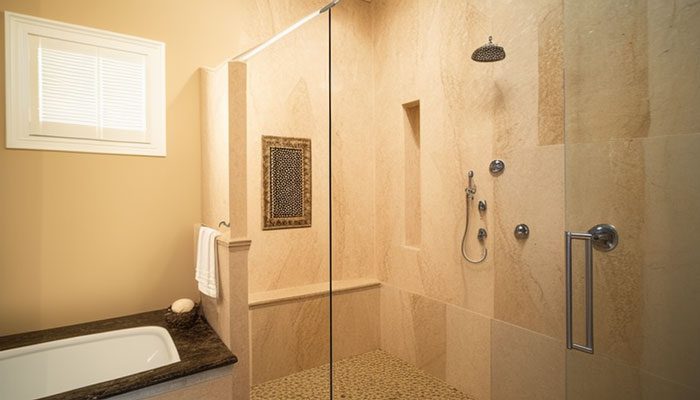
A vacuum should be used to clear away any dust or debris that may have accumulated in the affected area, allowing for a more thorough scrubbing. Also, make sure to wear gloves and safety goggles, as well as a mask if preferred.
Step 2: Application of a Detergent Solution
Once the preparation steps are complete, it’s time to apply a detergent solution to the affected area. To do this, mix together warm water and a mild (non-acidic) detergent or dish soap in a spray bottle or bowl.
Spraying it directly onto the travertine surface is best for hard-to-reach areas such as grout lines or crevices. Next, use a soft brush or sponge to apply the solution in circular motions over the moldy areas on your travertine shower walls or travertine flooring.
Ensuring you cover all visible patches of the mold with the detergent solution. Allow this floor cleaner to sit for 10-15 minutes before wiping it off with a damp cloth.
Step 3: Scrubbing with Baking Soda Mixture

For tougher stains that don’t come off after applying the detergent solution, create a paste mixture using baking soda and water and apply it over these stains using a soft brush or sponge. Scrubbing firmly in circular motions until all traces of dirt and grime have been removed from these surfaces of your travertine shower.
This paste mixture helps break down tough residue buildup while still being gentle enough not to damage your tile surface. Making sure no abrasive chemicals are used while scrubbing, as this could potentially damage your travertine floor tiles further.
Step 4: Finishing Touches
Once all traces of mold have been removed from your travertine shower area, there are some finishing touches you can do to prevent new growth in the future. For example, if you keep wet areas well-ventilated by opening windows whenever possible, it will help reduce humidity levels.
This can stop mold from growing on surfaces such as natural stone tile, like travertine, that is often used in showers and bathrooms. Afterward, rinse any remaining detergent or baking soda residue thoroughly with warm water.
Why Does Mold Form On Travertine Tiles?
Mold growth on travertine tiles is a common issue due to the porous nature of the stone and its ability to absorb moisture. Here are two main reasons travertine tiles grow mold:
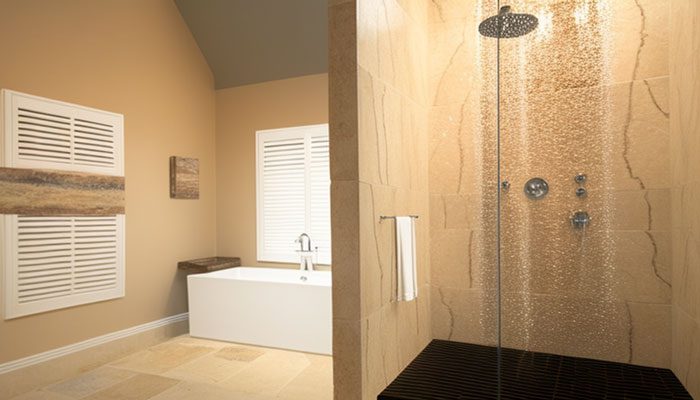
Environmental or Physical Conditions Causing Mold Growth
- High relative humidity levels
- Poor air circulation
- Poor ventilation
- Lack of sunlight exposure
- Leaking pipes or other water sources
- Moisture retention by the stone porous nature
- Improper cleaning and maintenance practices
Biological Factors Contributing to Mold Formation
- Microorganisms and spores in the environment
- Products with organic compounds that encourage mold growth
- Bacteria and fungal spores found in dirt, dust, and pollutants
How to Prevent Mold Accumulation On Travertine Tiles?
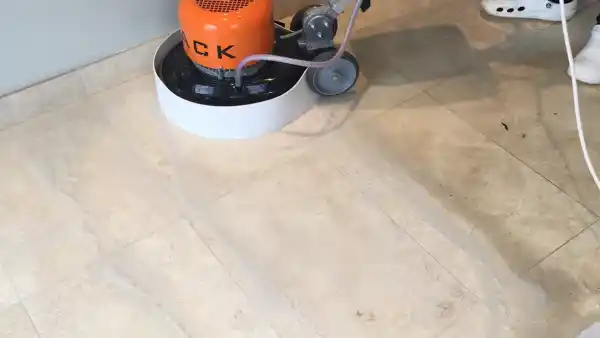
Mold and mildew can cause damage to your travertine tiles, so it’s important to take preventive steps to ensure the longevity of your flooring. Here are seven tips for keeping your travertine tile shower clean and mold-free:
1. Keep the Room Ventilated
Proper ventilation is key when it comes to preventing mold from accumulating on your travertine tiles. Ensure you leave windows open or use an exhaust fan while showering or doing laundry to help circulate air throughout the bathroom.
2. Dry Wet Surfaces After Use
Bathrooms are especially prone to mold accumulation, as they often contain high humidity levels. To reduce moisture levels, ensure that you wipe down any wet surfaces immediately after use and keep them dry at all times.
3. Clean the Tiles Regularly
Regular travertine cleaning with a mild detergent can help prevent mold growth on travertine tiles. Try to follow the above cleaning steps at least once a month to keep your travertine tiles looking their best.

4. Inspect Caulk Seals for Cracks
You should check the caulking around your tubs, showers, and sinks regularly for cracks or gaps. If there are any cracks or gaps, water and steam can get into them, and this could cause mold to grow on your tiles. If needed, seal up any gaps as soon as possible to avoid further damage.
5. Use Stone Sealers
Natural stone like travertine is porous by nature which makes it vulnerable to moisture seepage leading to mold formation if left untreated for long periods of time. Applying natural stone sealers every few years will help to protect the surface from moisture.
6 . Use Grout Sealants
Because the grouts between travertine tiles are very porous, you should also use sealants to protect against moisture and mold growth. Remember to always read the instructions that come with the product before using it on surfaces like natural stone, marble, or granite.
7 . Fix Leaks Promptly
Check your pipes regularly to see if any water leaks. Be extra careful around shower cubicles because these wet areas could create good conditions for mold to grow if there is also poor ventilation. You’ll be able to avoid more damage from dampness if you fix these problems immediately.
How Often Should You Clean Travertine Shower Tiles to Prevent Mold?
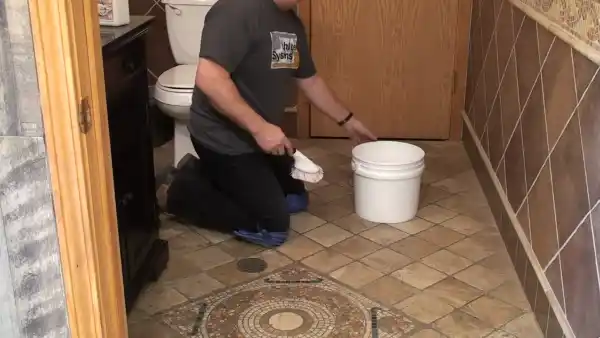
Cleaning travertine shower tiles against mold should be done on a regular basis. Depending on the frequency of use and the amount of dirt present, it is recommended that you sweep or vacuum the tile and grout weekly and mop it with a mild, natural cleaning solution.
This will help keep soap scum, oils, and other forms of debris from settling and create an environment conducive to mold growth. To reduce the likelihood of any bacterial or fungal growth, grout lines should also be scrubbed regularly with an old toothbrush to remove any trapped dirt particles.
Regularly checking for signs of mold is also essential. Look for discolorations in both the tile and grout, as this may be indicative of a problem. If you notice any signs of mold growth in your travertine shower tiles, it is best to remove them immediately.
Does Vinegar Work on Travertine Shower Mold?
No, vinegar should not be used directly on the travertine shower mold. The acidic nature of vinegar will damage the tiles and could lead to staining or further discoloration. Travertine is a softer stone material, which makes it vulnerable to acidic materials like vinegar.
To effectively clean the shower mold without damaging your travertine tiles, use a mild detergent and water solution instead. Make sure to rinse with clear water afterward and dry off any excess moisture with a soft towel or cloth.
If the mold persists, switch to an over-the-counter cleaner method that is mentioned above. These products are safe to use on travertine, as they typically do not contain acidic materials that could potentially damage the tile surface.
Is Bleach Safe For Removing Travertine Shower Mold?
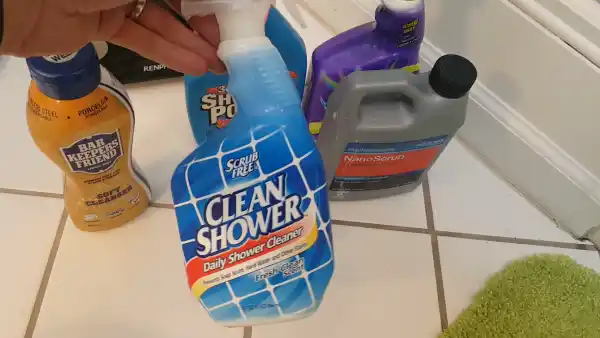
Using bleach to remove mold from your travertine shower can be effective. Although, it should only be done with caution as it can also be very damaging to the tiles if not used correctly. The recommended mix ratio for this application is 5% chlorine bleach to 95% water.
The tiles should be wiped down with a damp cloth after cleaning with bleach to prevent any remaining chlorine in the air from corroding them in the future. Also, since chlorine bleach has strong oxidizing properties, you should wear protective gloves and goggles when handling it and apply it sparingly.
Combat Moldy Travertine: Take Control with the Right Knowledge & Maintenance
As you can see, cleaning and preventing mold from forming on travertine shower tiles is not difficult. It just requires a little knowledge and some basic maintenance steps. Using the above proper cleaning techniques and frequently wiping down your surfaces can help you prevent mold from growing on travertine pavers.
We hope this blog post has helped you better understand how to care for your travertine shower tile so that it continues looking its very best.

